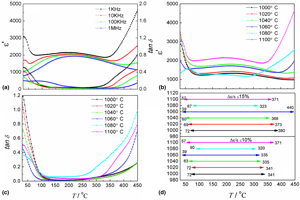Crossref Citations
This article has been cited by the following publications. This list is generated based on data provided by
Crossref.
Sun, Ying
Liu, Hongbo
Liu, Fangchao
and
Liu, Gang
2021.
Dielectric and electrical energy storage properties of BiFeO3–BaTiO3–SrTiO3 ternary bulk ceramics.
Journal of Materials Science: Materials in Electronics,
Vol. 32,
Issue. 16,
p.
21188.
Huang, Wenbin
and
Liu, Hongbo
2022.
Antiferroelectric NaNbO3 ceramics prepared by hydrothermal-assisted cold sintering process.
Journal of Materials Science: Materials in Electronics,
Vol. 33,
Issue. 2,
p.
683.
Jiang, Zehua
Yuan, Ying
Yang, Hongcheng
Li, Enzhu
and
Zhang, Shuren
2022.
Superior thermal stability and energy storage properties of (1-x)Na0.3Bi0.3Ba0.04Sr0.36TiO3-xZnTa2O6 lead-free ceramic.
Journal of Alloys and Compounds,
Vol. 906,
Issue. ,
p.
164345.
Li, Yan
and
Liu, Hongbo
2022.
Electrical energy storage properties of AgNbO3-based antiferroelectric ceramics prepared without an oxygen atmosphere by using hydrothermally synthesized powders.
Ferroelectrics,
Vol. 600,
Issue. 1,
p.
1.
Hai, Liangwen
and
Liu, Hongbo
2022.
Effects of Mn doping on electrical properties of BiFeO3–SrTiO3 solid solution.
Solid State Communications,
Vol. 343,
Issue. ,
p.
114652.
Jiang, Zehua
Yuan, Ying
Yang, Hongcheng
Li, Enzhu
and
Zhang, Shuren
2022.
Excellent thermal stability and energy storage properties of lead‐free Bi0.5Na0.5TiO3‐based ceramic.
Journal of the American Ceramic Society,
Vol. 105,
Issue. 6,
p.
4027.
Li, Bin
Liu, Hongbo
Sun, Ying
Cao, Yule
and
Guo, Yinben
2022.
Improved triboelectric performance of polydimethylsiloxane reinforced with ferroelectric composite oxide.
Journal of Materials Science: Materials in Electronics,
Vol. 33,
Issue. 8,
p.
5335.
Hou, Shuiting
Wang, Xiao
Liu, Xin
Liu, Xiaoyu
Lu, Jiangbo
Liang, Pengfei
Wu, Di
Chao, Xiaolian
Yang, Zupei
and
Wei, Lingling
2023.
Significant increase in comprehensive energy storage performances of Ca0.5(Sr0.5Ba0.5)2Nb5O15-based tungsten bronze relaxor ceramics.
Journal of the European Ceramic Society,
Vol. 43,
Issue. 15,
p.
6854.
Wang, Huan
and
Liu, Hongbo
2023.
Enhanced electrical energy storage performance under low electric fields in Bi(Mg2/3Nb1/3)O3-modified 0.76Bi0.5Na0.5TiO3-0.24SiTiO3 ceramics.
Journal of Materials Science: Materials in Electronics,
Vol. 34,
Issue. 7,
Dong, Rizhuang
Shi, Jing
Li, Yujing
Tian, Wenchao
and
Liu, Xiao
2024.
Dielectric energy storage properties of low-temperature sintered BNT-based ceramics with LiF and B2O3–Bi2O3 as sintering aids.
Ceramics International,
Li, Xinheng
Yang, Hang
Zhu, Chaoqiong
Li, Shiheng
Li, Aoyu
Cai, Ziming
and
Feng, Peizhong
2024.
Enhanced high-temperature energy storage properties in BNT-based ceramics with well-controlled low dielectric loss.
Ceramics International,
Vol. 50,
Issue. 1,
p.
1438.






